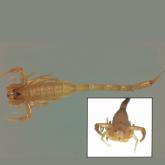Article

What’s Eating You? Bark Scorpions (Centruroides exilicauda and Centruroides sculpturatus)
- Author:
- Avni Patel, BS
- Dirk M. Elston, MD
Stings from Centruroides exilicauda and Centruroides sculpturatus have been shown to cause fatality in children more often than...
